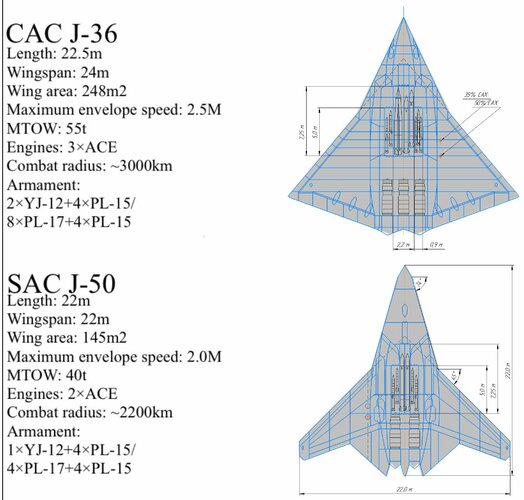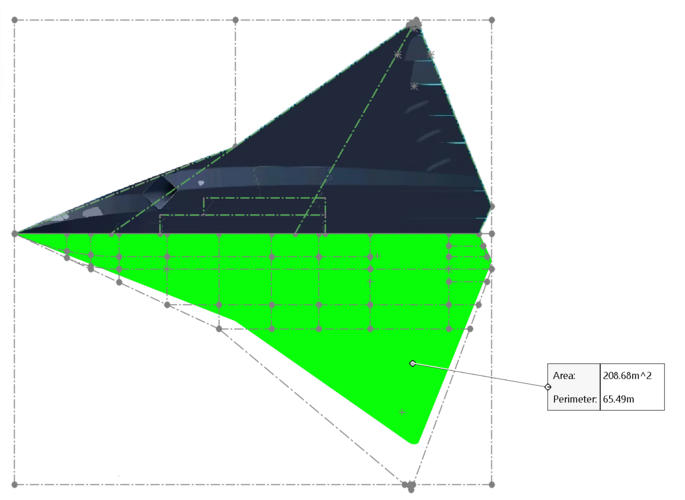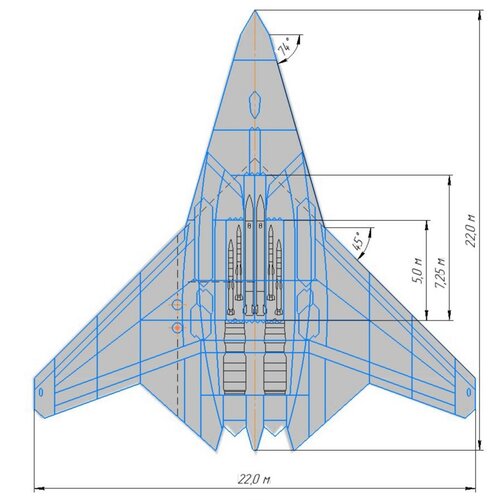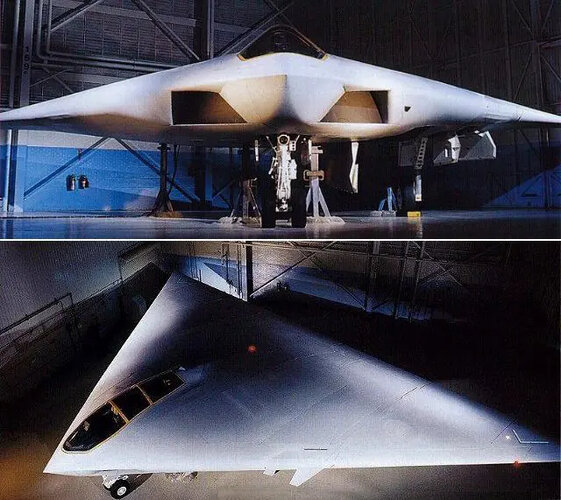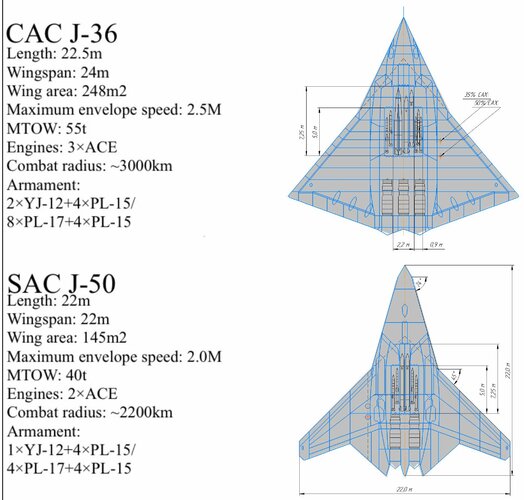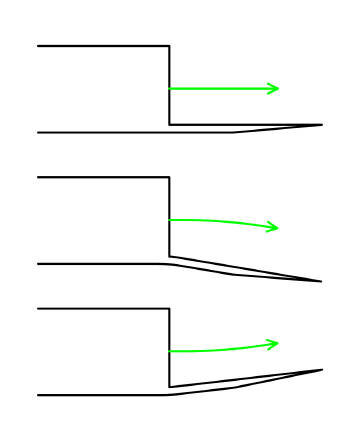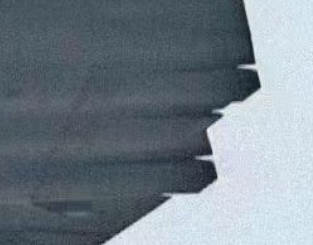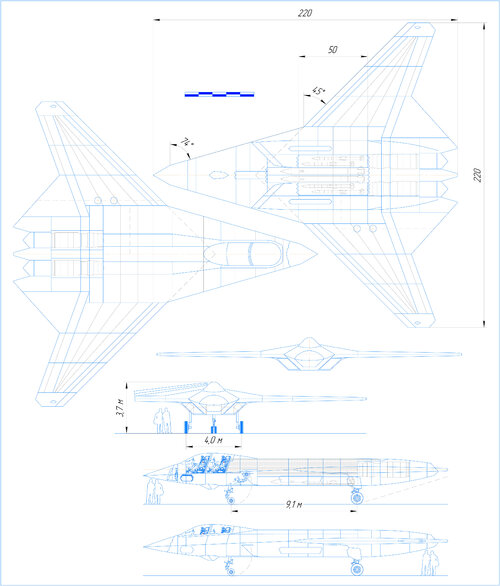You are using an out of date browser. It may not display this or other websites correctly.
You should upgrade or use an alternative browser.
You should upgrade or use an alternative browser.
Shenyang / Chengdu "6th Gen" Aircraft - News and Analysis
- Thread starter tequilashooter
- Start date
- Joined
- 24 November 2008
- Messages
- 1,554
- Reaction score
- 2,627
- Joined
- 27 December 2005
- Messages
- 17,768
- Reaction score
- 26,583
I think I agree - the wider platform just doesn't seem steamlined enough to look supersonic.
Without a true top or bottom view its difficult to be certain on the angles.
Without a true top or bottom view its difficult to be certain on the angles.
The K2
ACCESS: Secret
- Joined
- 29 June 2020
- Messages
- 304
- Reaction score
- 686
I agree. Its got to be a tandem seater. As far as a wide cockpit, I think of the A-12:but why would you need such a long cockpit canopy? there's literally room for another row of two people after the front row. Would it not be more logical to keep the canopy shorter than shown, if seating is side by side and if there are 2 pilots inside? It's stealthier, probably cheaper to have a smaller canopy and it's not like this thing is gonna rely on visibility from the cockpit so much.
Attachments
Characteristics of the J-50
Length 22 m
Wingspan 22 m
Height 3.7 m
The wing area is 159 m2
Volume 92 m3
The volume of weapon bays is 11.3 m3 / 12.3%
Weight:
Maximum 46,000 kg
The normal weight is 34,000 kg
Fuel 12000 kg / additional tank 4000 kg
Loads of 12,000 kg
Empty 21650 kg
Engines:
Thrust 2 x 15400 kgf / 9500 kgf
Fuel consumption 0.67 kg/kgf*h
Maximum speed 1600 km/h, M=1.5
Cruising speed 1300 km/h, M = 1.2
Flight range:
Subsonic 2,800 km
Supersonic 1300 km
Subsonic with one tank in weapon Bays 3650 km
Operating overload 7.5g
RCS minimum 0.24 m2
RCS max 4.24 m2
2 PL-17 + 4 PL-15 = 2 * 400 kg + 4 * 225 kg = 1715 kg
4 FAB-500 + 4 PL-15 = 2900 kg
1 PTB-4000 + 4 PL-15 = 1 * 4300 kg + 4 * 225 kg = 5200 kg
Total combat effectiveness 3.46
J-20 – 1.9, F-22 – 2.14, NGAD – 3.74, Su-57 – 3.24
Length 22 m
Wingspan 22 m
Height 3.7 m
The wing area is 159 m2
Volume 92 m3
The volume of weapon bays is 11.3 m3 / 12.3%
Weight:
Maximum 46,000 kg
The normal weight is 34,000 kg
Fuel 12000 kg / additional tank 4000 kg
Loads of 12,000 kg
Empty 21650 kg
Engines:
Thrust 2 x 15400 kgf / 9500 kgf
Fuel consumption 0.67 kg/kgf*h
Maximum speed 1600 km/h, M=1.5
Cruising speed 1300 km/h, M = 1.2
Flight range:
Subsonic 2,800 km
Supersonic 1300 km
Subsonic with one tank in weapon Bays 3650 km
Operating overload 7.5g
RCS minimum 0.24 m2
RCS max 4.24 m2
2 PL-17 + 4 PL-15 = 2 * 400 kg + 4 * 225 kg = 1715 kg
4 FAB-500 + 4 PL-15 = 2900 kg
1 PTB-4000 + 4 PL-15 = 1 * 4300 kg + 4 * 225 kg = 5200 kg
Total combat effectiveness 3.46
J-20 – 1.9, F-22 – 2.14, NGAD – 3.74, Su-57 – 3.24
Last edited:
Characteristics of the J-50
Length 22 m
Wingspan 22 m
Height 3.7 m
The wing area is 159 m2
Volume 92 m3
The volume of weapon bays is 11.3 m3 / 12.3%
Weight:
Maximum 46,000 kg
The normal weight is 34,000 kg
Fuel 12000 kg / additional tank 4000 kg
Loads of 12,000 kg
Empty 21650 kg
Engines:
Thrust 2 x 15400 kgf / 9500 kgf
Fuel consumption 0.67 kg/kgf*h
Maximum speed 1600 km/h, M=1.5
Cruising speed 1300 km/h, M = 1.2
Flight range:
Subsonic 2,800 km
Supersonic 1300 km
Subsonic with one tank in weapon Bays 3650 km
Operating overload 9g
RCS minimum 0.24 m2
RCS max 4.24 m2
2 PL-17 + 4 PL-15 = 2 * 400 kg + 4 * 225 kg = 1715 kg
4 FAB-500 + 4 PL-15 = 2900 kg
1 PTB-4000 + 4 PL-15 = 1 * 4300 kg + 4 * 225 kg = 5200 kg
Total combat effectiveness 3.5
J-20 – 1.9, F-22 – 2.14, NGAD – 3.74, Su-57 – 3.24
Where did you get the length 22 m?
Where did you get the length 22 m?
In this image, the view of the J-36 completely matches the photo, so I trust the image of the J-50 as well
With 23100 kgf / 14250 kgf engines, the J-50 gets a maximum speed of 1,900 km/h, a cruising speed of 1,500 km/h, a range without an additional tank of 3,000 km, with an additional tank of 4,000 km, a supersonic range of 1,600 km
Last edited:
Jackonicko
ACCESS: Secret
- Joined
- 4 February 2009
- Messages
- 387
- Reaction score
- 916
I may have been asleep, but 'J-50'? Why?
- Joined
- 8 March 2009
- Messages
- 1,058
- Reaction score
- 1,306
The cut between the engines is probably the same angle as the TE
siegecrossbow
I really should change my personal text
- Joined
- 12 March 2012
- Messages
- 731
- Reaction score
- 2,222
I may have been asleep, but 'J-50'? Why?
Just some naming convention people are speculating about. No evidence that the designation is J-50.
So where is the thinking at with regard to both reheat and thrust vectoring?
I don't know about reheat but if all three nozzles are vector able then the J-36 could pitch and roll at the same time with the nozzles.
That would be SkyrayMan this thing is absolutely stunning. Probably the closest thing to a flying saucer Earth ever created.
About intakes--what we see here may not be what is put into production.
Would it be possible to have the top-mount intake alone provide air for the engines at a reduced rate, so the lower intakes can be blocked with stealth plates?
siegecrossbow
I really should change my personal text
- Joined
- 12 March 2012
- Messages
- 731
- Reaction score
- 2,222
FlyGuy369
Flying is fantastic
- Joined
- 15 June 2023
- Messages
- 257
- Reaction score
- 701
Flexible thrust vectoring panels like the control surfaces? Thrust angle is key!There is a theory on type of thrust vectoring employed by the J-36, but take with mountain of salt until we have better quality picts.
View attachment 754549
View attachment 754550
View attachment 754551
Now this question I have will seem insane--maybe it is.
How big of an airframe to you need to put jets in backwards--thrust pushing forward then routed to go out through what looks like a triple exhaust?
How cool would that exhaust be then--with a top blowhole to cool things further?
This might just have two engines after all.
Just use niobium for exhaust routing?
How big of an airframe to you need to put jets in backwards--thrust pushing forward then routed to go out through what looks like a triple exhaust?
How cool would that exhaust be then--with a top blowhole to cool things further?
This might just have two engines after all.
Just use niobium for exhaust routing?
red admiral
ACCESS: Top Secret
- Joined
- 16 September 2006
- Messages
- 1,818
- Reaction score
- 2,409
The fuselage is still not very fine, and with quite a bluff nose, regardless of the exact sweep on the wing.I think I agree - the wider platform just doesn't seem steamlined enough to look supersonic.
X-45C Phantom Ray or NeUrOn seem quite a lot more streamlined than this when you compare.
Forest Green
ACCESS: Above Top Secret
- Joined
- 11 June 2019
- Messages
- 9,586
- Reaction score
- 17,684

New Chinese Combat Aircraft Likely a Medium-Range Bomber
Photos of new Chinese combat aircraft flying suggest a new medium bomber and fighter-sized jet in the works.
For some reason Western Analysts just can't comprehend that China could build a different kind of fighter platform, there's been plenty of information pointing to this not being a simple 'medium-range bomber'.
New Chinese Combat Aircraft Likely a Medium-Range Bomber
Photos of new Chinese combat aircraft flying suggest a new medium bomber and fighter-sized jet in the works.www.airandspaceforces.com
- Joined
- 17 October 2006
- Messages
- 2,393
- Reaction score
- 1,198

New Chinese Combat Aircraft Likely a Medium-Range Bomber
Photos of new Chinese combat aircraft flying suggest a new medium bomber and fighter-sized jet in the works.www.airandspaceforces.com

Forest Green
ACCESS: Above Top Secret
- Joined
- 11 June 2019
- Messages
- 9,586
- Reaction score
- 17,684
There's a logic to it. It does look most like an FB-22 but I'm not going to claim to know something I do not.
siegecrossbow
I really should change my personal text
- Joined
- 12 March 2012
- Messages
- 731
- Reaction score
- 2,222
I think we are at the stage where single role aircraft are becoming less and less economical. That said, some of the comments in the article gave off hints of “we’ve got a handle on China intel so this was no surprise to us”.
djfawcett
With Enough Power, Anything Will Fly
- Joined
- 16 December 2012
- Messages
- 275
- Reaction score
- 425
Thrust vectoring would cause a significant redesign, But the real issue is why? If this vehicle found itself in a turning fight, the result would be a J-36 littering the battle field.Currently I do not think that the J-36 will have trust vectoring Avimimus. Though that could change over time as more information comes out.
New Chinese Advanced Combat Aircraft Emerge In Flight | Aviation Week Network
Internet images show a new Chinese combat aircraft with a cockpit and stealthy configuration, including a diamond-style wing with no vertical tails.
Scott Kenny
ACCESS: USAP
- Joined
- 15 May 2023
- Messages
- 11,737
- Reaction score
- 14,524
The two small doors suggest some interesting things, like being able to open them to spit out an AAM for minimal time the doors are open.As I said, CGs, sketches or drawings of the SAC design are rare so far ... yesterday the great animation by @xmszeon and today I found this on FB.
(via @隨心所欲)
View attachment 754475
Could the canopy be doing something as a DSI bump?but why would you need such a long cockpit canopy? there's literally room for another row of two people after the front row. Would it not be more logical to keep the canopy shorter than shown, if seating is side by side and if there are 2 pilots inside? It's stealthier, probably cheaper to have a smaller canopy and it's not like this thing is gonna rely on visibility from the cockpit so much.
I would not expect a T:W above 1 until the plane is most of the way to combat radius and so has burned off roughly half the fuel load.Looks too big; PL-17s don't fit in. Also, 1.2 t:w at MTOW surely is excessive?
Because it's the first "fifth generation" fighter? (Chinese generation counting says J-11 is 3rd generation, J-20 is 4th, and this would be 5th)I may have been asleep, but 'J-50'? Why?
siegecrossbow
I really should change my personal text
- Joined
- 12 March 2012
- Messages
- 731
- Reaction score
- 2,222
Because it's the first "fifth generation" fighter? (Chinese generation counting says J-11 is 3rd generation, J-20 is 4th, and this would be 5th)
Chinese designation has changed to J-20/J-35 being fifth gen since around 2020.
F-14ATomcat
ACCESS: Secret
- Joined
- 26 May 2024
- Messages
- 480
- Reaction score
- 915
Through out history the concept of fighter has changed and there have been many types of fighters.For some reason Western Analysts just can't comprehend that China could build a different kind of fighter platform, there's been plenty of information pointing to this not being a simple 'medium-range bomber'.
From BF-110 which was a heavy fighter to Do-335 which was also another type of heavy fighter.
Later You have aircraft like Yak-28 or Tu-128.
However a fighter should be agile (at least in the main concept) I do not think it is about western analysts, but more about the landing gear J-36 has in the nose landing gear two wheels and so are the main landing gears, they also have two wheels.
This suggest a very heavy aircraft, so when you have heavy weight aircraft it is hard to think J-36 is a fighter, at least not a nimble one.
MiG-25 is a fighter, well an interceptor but is heavy same MiG-31, but it seems J-36 weighs much more than these two aircraft, I have no idea about the weight but my guess is this aircraft J-36 weighs around 24,000 to 26,000kg. empty weight. The F-22 is 19000kg and the MiG-31 around 22000kg but MiG-31 has no internal weapons bays and it has only 2 engines.
So i would say it weighs more than a MiG-31 at max take off, MiG-31 goes up to 46000kg.
So I would consider it needs lots of fuel to power 3 engines so a max take of of 55000kg could be possible.
At that weight, has a weight of a bomber, lots of weight means basically at 6Gs or 8Gs the structure will be under high stress, so I think this aircraft has a 3G to 5G limit.
So in my humble opinion this is a very heavy interceptor akin to Tu-128
"While delta wings are critical to achieving high lift for supersonic flight, they also have a number of disadvantages for less high-performing aircraft. They require high landing and takeoff speeds and long takeoff and landing runs, are unstable at high angles of attack, and produce tremendous drag when "trimmed" to keep the plane level. Of these disadvantages, pilots and designers usually consider the high landing and takeoff speeds the most important because they make flying the plane dangerous. Indeed, when the Concorde had its first ever crash in 2000, after two decades of safe operations, the high-speed takeoff was a factor in this terrible accident, for the plane's high ground speed before becoming airborne placed major stress upon the aircraft's tires, which exploded upon striking an object on the runway."
Last edited:
- Joined
- 8 March 2009
- Messages
- 1,058
- Reaction score
- 1,306
Dan Raymers RIVET concept.How big of an airframe to you need to put jets in backwards--thrust pushing forward then routed to go out through what looks like a triple exhaust?
- Joined
- 17 October 2006
- Messages
- 2,393
- Reaction score
- 1,198
I hate to say "think lasers" but it may be time to think lasers...

 www.aspistrategist.org.au
www.aspistrategist.org.au

China's big new combat aircraft: an airborne cruiser against air and surface targets | The Strategist
The speed, agility, range and stealth of an individual aircraft type are still important, but they’re no longer the whole story of air combat. Advances in sensing, processing and communications are changing military operations. The ...
- Joined
- 6 August 2007
- Messages
- 3,904
- Reaction score
- 6,041
I hate to say "think lasers" but it may be time to think lasers...
That was 2015 and it didn’t end up turning out so well for the contractors.
How would a laser work through all that smog in China?
Scott Kenny
ACCESS: USAP
- Joined
- 15 May 2023
- Messages
- 11,737
- Reaction score
- 14,524
One bigger than just using 3 engines. You'd also lose at least 1/3 the thrust of the engine in the ductwork.How big of an airframe to you need to put jets in backwards--thrust pushing forward then routed to go out through what looks like a triple exhaust?
To start, we have seen western analysts try and reason that the J-20 isn't an air superiority fighter but is more like akin a interceptor for high valued targets like tankers or AWACS. Nevertheless, the Chinese designed and intended the J-20 to be it's premier air superiority fighter. Not an interceptor. What I see is a kind of disconnect between what it means for something to be a fighter for the Chinese versus the west so to speak. Honestly the lack of a gun was probably a big reason as to why the train of thought first appeared, and I see this same train of thought appearing again for the J-36 like Deja vu.Through out history the concept of fighter has changed and there have been many types of fighters.
From BF-110 which was a heavy fighter to Do-335 which was also another type of heavy fighter.
Later You have aircraft like Yak-28 or Tu-128.
However a fighter should be agile (at least in the main concept) I do not think it is about western analysts, but more about the landing gear J-36 has in the nose landing gear two wheels and so are the main landing gears, they also have two wheels.
This suggest a very heavy aircraft, so when you have heavy weight aircraft it is hard to think J-36 is a fighter, at least not a nimble one.
MiG-25 is a fighter, well an interceptor but is heavy same MiG-31, but it seems J-36 weighs much more than these two aircraft, I have no idea about the weight but my guess is this aircraft J-36 weighs around 24,000 to 26,000kg. empty weight. The F-22 is 19000kg and the MiG-31 around 22000kg but MiG-31 has no internal weapons bays and it has only 2 engines.
So i would say it weighs more than a MiG-31 at max take off, MiG-31 goes up to 46000kg.
So I would consider it needs lots of fuel to power 3 engines so a max take of of 55000kg could be possible.
At that weight, has a weight of a bomber, lots of weight means basically at 6Gs or 8Gs the structure will be under high stress, so I think this aircraft has a 3G to 5G limit.
So in my humble opinion this is a very heavy interceptor akin to Tu-128
"While delta wings are critical to achieving high lift for supersonic flight, they also have a number of disadvantages for less high-performing aircraft. They require high landing and takeoff speeds and long takeoff and landing runs, are unstable at high angles of attack, and produce tremendous drag when "trimmed" to keep the plane level. Of these disadvantages, pilots and designers usually consider the high landing and takeoff speeds the most important because they make flying the plane dangerous. Indeed, when the Concorde had its first ever crash in 2000, after two decades of safe operations, the high-speed takeoff was a factor in this terrible accident, for the plane's high ground speed before becoming airborne placed major stress upon the aircraft's tires, which exploded upon striking an object on the runway."
You point out the size and lack of high maneuverability as a reason why the J-36 is more akin to a heavy interceptor than a air superiority fighter. I don't share the same viewpoint. I see a successor of the J-20, building on the J-20's strengths, and a air superiority fighter that follows the Chinese doctrine where dogfighting is viewed as an obsolete concept. Agility traditionally was used to fight to either gain an upper hand, or defend yourself. Emerging technologies can basically render the usefulness of extreme agility pointless.
This is the kind of fighter concept where it achieves air superiority through complete air denial. If an AWACS is an early warning and control plane, the J-36 could be described along the lines as a air superiority and control fighter. This is why some commentators are trying to classify it as a "air destroyer" or "air cruiser" kind of aircraft.
In the modern day the differences are becoming blurred in-between the lines again, we've seen this with ships, it's about time when these large all mission capable aircraft take to the skies completely blowing out the traditional classifications we've had for decades. From 10k ton frigates to main battle tanks.
Honestly calling it a heavy interceptor at this point isn't exactly wrong, it seems that it has roles across the spectrum of aircraft. Are reaching near definition of a "multi-role" fighter aircraft. But what I think we can all agree on is that this isn't a bomber of any kind. There are just so many indicators pointing to it's air to air focused role.
Of course I could be completely wrong about this and somehow this is indeed a bomber-of kind. If it turns out this way, I'll be promptly having a full course meal of shoes and hats. This is just my opinion when looking at some Chinese sources and history.
siegecrossbow
I really should change my personal text
- Joined
- 12 March 2012
- Messages
- 731
- Reaction score
- 2,222
That was 2015 and it didn’t end up turning out so well for the contractors.
How would a laser work through all that smog in China?

Beijing's battle to clean up its air
Beijing has made great strides in curbing vehicle emissions and pushing electric mobility, and in the process, improved the air quality for its 21 million citizens.
www.unep.org
Scott Kenny
ACCESS: USAP
- Joined
- 15 May 2023
- Messages
- 11,737
- Reaction score
- 14,524
Except this is most likely going to replace J-11s and Russian-built Flankers, not the very new J-20s. So a successor in concept, not a replacement.To start, we have seen western analysts try and reason that the J-20 isn't an air superiority fighter but is more like akin a interceptor for high valued targets like tankers or AWACS. Nevertheless, the Chinese designed and intended the J-20 to be it's premier air superiority fighter. Not an interceptor. What I see is a kind of disconnect between what it means for something to be a fighter for the Chinese versus the west so to speak. Honestly the lack of a gun was probably a big reason as to why the train of thought first appeared, and I see this same train of thought appearing again for the J-36 like Deja vu.
You point out the size and lack of high maneuverability as a reason why the J-36 is more akin to a heavy interceptor than a air superiority fighter. I don't share the same viewpoint. I see a successor of the J-20, building on the J-20's strengths, and a air superiority fighter that follows the Chinese doctrine where dogfighting is viewed as an obsolete concept. Agility traditionally was used to fight to either gain an upper hand, or defend yourself. Emerging technologies can basically render the usefulness of extreme agility pointless.
The PLAAF has ~330 old J-7 and J-8 interceptors it needs to replace. I suspect that the squadrons equipped with J-11s, Su-27s, and Su-35s will get re-equipped with J-36s, and their various Flankers will get pushed to the interceptor squadrons since the Flankers are all relatively new. At the very tail end of production, the J-16 Flankers will get replaced with J-36s, leaning on the large internal bays for fast strike work. That's a total run of about 500-550x J-36s, which is a pretty respectable run.
I further suspect that the ~100x Su-30s will get replaced with J-20s, multirole for multirole.
Which leaves the 200x JH-7s. I think these are getting replaced by the J-35s.
H-6s obviously get replaced by the H-20, so there's ~200x H-20s.
And that gives the PLAAF a road map to an inventory of 100% stealthy combat aircraft.
I think the definition of a "bomber" as something with "high payload and low maneuver limits with little-to-no AA capability" is still a valid definition, but in terms of fighters or multi-role I think you're right. We're at the point where the definition of a "fighter" as "something with high maneuverability to win WVR dogfights" is likely at the end of its usefulness.In the modern day the differences are becoming blurred in-between the lines again, we've seen this with ships, it's about time when these large all mission capable aircraft take to the skies completely blowing out the traditional classifications we've had for decades. From 10k ton frigates to main battle tanks.
I think s/n 36011 is an "interceptor" with some strike capabilities, including a bay large enough for heavy antiship weapons and the extreme-range AAMs. "Interceptor" in quotes because it's intended as a BVR fighter, with limited WVR capabilities in favor of VLO or even ELO stealth levels.Honestly calling it a heavy interceptor at this point isn't exactly wrong, it seems that it has roles across the spectrum of aircraft. Are reaching near definition of a "multi-role" fighter aircraft. But what I think we can all agree on is that this isn't a bomber of any kind. There are just so many indicators pointing to it's air to air focused role.
Of course I could be completely wrong about this and somehow this is indeed a bomber-of kind. If it turns out this way, I'll be promptly having a full course meal of shoes and hats. This is just my opinion when looking at some Chinese sources and history.
I hate to say "think lasers" but it may be time to think lasers...

China's big new combat aircraft: an airborne cruiser against air and surface targets | The Strategist
The speed, agility, range and stealth of an individual aircraft type are still important, but they’re no longer the whole story of air combat. Advances in sensing, processing and communications are changing military operations. The ...www.aspistrategist.org.au
Nice article, a few minor comments.
"Potential internal loads include such long-range air-to-air missiles as the PL-15, which the J-20 cannot carry internally."
- The J-20 can carry PL-15 internally (it is a regular sized BVRAAM, of which it can carry four of, and likely carry six of the new folding wing version). The outsized BVRAAM you're thinking of is called "PL-17" these days
Regarding KJ-3000, tbh I doubt its concops in a high end conflict would involve being based more "forward" because after all that would also make it much more vulnerable to opfor BVRAAM and VLRAAMs as well. I suspect KJ-3000 in a high end conflict will be more used as a "rear surveillance+command center" in the traditional AEW&C and battle manager role, albeit with next generation sensing, processing and networking capabilities with various next gen assets. If there is to be a "forward" employed AEW asset, I think the WZ-9 AEW UAV would be somewhat more willing to be risked closer to the frontline.
I also think there could have been a paragraph or two regarding the PLA's own pursuit of UCAVs/CCAs, of which there are a couple of types that we know they are actively developing/flying/procuring, and likely many that we are not aware of. After all, what's good for the goose is good for the gander, and in the same way that whatever platform NGAD ends up being will benefit from UCAVs/CCAs, it is likely J-36 will do so as well.
I'm not fully convinced whether this thing will have a DEW in those side apertures (I'm skeptical if anything), but I do think the aircraft does have a major focus on power generation, but I see it as primarily being intended to support uber amounts of onboard processing, networking, sensors, and integration.
Scott Kenny
ACCESS: USAP
- Joined
- 15 May 2023
- Messages
- 11,737
- Reaction score
- 14,524
I expect those two forward-looking glass apertures to be for IRST systems. (Air search, not the ground attack that EOTS seems to imply these days)I'm not fully convinced whether this thing will have a DEW in those side apertures (I'm skeptical if anything),
For example, the YF-12s carried a pair of IRSTs, and they were able to triangulate the range to target reasonably well off a ~12ft base length. The two glass apertures look to be at least 3m if not 4m apart, so would be equally capable of getting range to a target detected via IR.
F-14ATomcat
ACCESS: Secret
- Joined
- 26 May 2024
- Messages
- 480
- Reaction score
- 915
well modern 6th Generation aircraft are supposed to control UCAVs, these UCAVs are the ones fighting so yes they are like AWACs, the future maybe a one without manned aircraft.To start, we have seen western analysts try and reason that the J-20 isn't an air superiority fighter but is more like akin a interceptor for high valued targets like tankers or AWACS. Nevertheless, the Chinese designed and intended the J-20 to be it's premier air superiority fighter. Not an interceptor. What I see is a kind of disconnect between what it means for something to be a fighter for the Chinese versus the west so to speak. Honestly the lack of a gun was probably a big reason as to why the train of thought first appeared, and I see this same train of thought appearing again for the J-36 like Deja vu.
You point out the size and lack of high maneuverability as a reason why the J-36 is more akin to a heavy interceptor than a air superiority fighter. I don't share the same viewpoint. I see a successor of the J-20, building on the J-20's strengths, and a air superiority fighter that follows the Chinese doctrine where dogfighting is viewed as an obsolete concept. Agility traditionally was used to fight to either gain an upper hand, or defend yourself. Emerging technologies can basically render the usefulness of extreme agility pointless.
This is the kind of fighter concept where it achieves air superiority through complete air denial. If an AWACS is an early warning and control plane, the J-36 could be described along the lines as a air superiority and control fighter. This is why some commentators are trying to classify it as a "air destroyer" or "air cruiser" kind of aircraft.
In the modern day the differences are becoming blurred in-between the lines again, we've seen this with ships, it's about time when these large all mission capable aircraft take to the skies completely blowing out the traditional classifications we've had for decades. From 10k ton frigates to main battle tanks.
Honestly calling it a heavy interceptor at this point isn't exactly wrong, it seems that it has roles across the spectrum of aircraft. Are reaching near definition of a "multi-role" fighter aircraft. But what I think we can all agree on is that this isn't a bomber of any kind. There are just so many indicators pointing to it's air to air focused role.
Of course I could be completely wrong about this and somehow this is indeed a bomber-of kind. If it turns out this way, I'll be promptly having a full course meal of shoes and hats. This is just my opinion when looking at some Chinese sources and history.
But increasing the size of a fighter only has one explanation, long range and high payload.
But AWACs have very large radars and 6th generation fighters I do not think can set such powerful radars.
3 engines mean low producibility, Imagine what limited the numbers of MiG-29 and F/A-18, versus F-16?
F-16 only needs a single engine and engine that was common to F-15.
Now 3 engines means more time to make and more expensive, this translate in lower numbers made.
Attack aircraft since the early 20th century were multi-engined aircraft.
B-29 4 engines, P-51 a single engine.
B-1B 4 engines, F-16 a single engine.
B-52 8 engines, F-8 one engine.
It is hard to say, at least for me now, but aircraft like Su-75 or F-35 in my point of view make more sense, as fighters because fighters need numbers, but if UCAVs become the new fighters well J-36 is only an AWACs but if lighter and more nimble UCAVs intercept it the drone has no human inside and being smaller will down the J-36 and to be honest I think even a JAS-39 will down J-36 if it finds it but who knows time will tell.
Scott Kenny
ACCESS: USAP
- Joined
- 15 May 2023
- Messages
- 11,737
- Reaction score
- 14,524
I believe that the J-36 is running 3x WS-10 engines, same engines as in the J-11/15/16 and J-20. So, large production run, lots of spare parts, and getting the incremental cost down to a minimum.3 engines mean low producibility, Imagine what limited the numbers of MiG-29 and F/A-18, versus F-16?
F-16 only needs a single engine and engine that was common to F-15.
That would give roughly 90klbs thrust, and suggests a MTOW in the neighborhood of 125klbs. (It's got landing gear like a Su-34 + 25% for IWBs etc based on difference between F-15 and F-22)
Similar threads
-
-
Shenyang FC-31 demonstrators / J-35 naval fighter / J-35A land-based version
- Started by Foxglove
- Replies: 1K
-
-
-
Chinese test of Fractional Orbital Bombardment System
- Started by Flyaway
- Replies: 100

